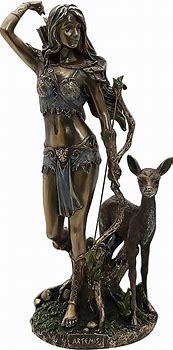
Roman Goddess Diana from gods-and-goddesses.com
Long before popular culture yielded such proficient female characters as Katniss Everdeen, Roman mythology held its own bow and arrow wielding huntress. According to the ancient Roman religion, Diana was the virgin goddess both of hunting and of wild and domestic animals themselves. Her name is derived from the Greek words diviana, dium and dius, meaning “the shining one,” “sky,” and “daylight,” respectively. Diana was considered a fertility goddess, a helper of women during conception and childbirth. It was believed that Diana could help a woman deliver a baby easily and safely. She was also associated with worship of the moon.
Diana Facts
Origins
It is thought that Diana may have originated as “an indigenous woodland goddess,” or a local deity. In time, however, she was associated with the Greek goddess Artemis and came to share her mythology. Even before Rome became an empire, during the time of the Latin League of cities, she was worshiped as Diana Nemorensis, or “Diana of the Wood,” by torch-bearing processions in the sacred forests on the shores of a lake near Rome. Here, she was part of a triad, or trinity, of deities including the river spirit Egeria, a guardian of childbirth, and Virbius, the first priest of Diana’s cult. Custom held that Diana’s priests be escaped slaves, and that to attain the priesthood, they first had to kill the preceding priest in combat using only a branch broken from a tree. Other worship took place on a mountain called Tifata, located near Capua.
Symbols
In statues and artwork, Diana is depicted as carrying a bow and a quiver of arrows, often accompanied by a hound (a hunting dog) or a deer. She is typically lightly clad, perhaps with a short dress or only a draping cloth, or wearing nothing at all.
Myths and Stories
Diana’s myths closely mirror those of her Greek counterpart Artemis. For example, the Roman poet Ovid recounts Actaeon’s unfortunate encounter with her. Diana was said to be a virgin, and was lauded for her purity. Diana had been hunting in a sacred valley which no humans had ever before touched. When she became tired, she and her nymphs bathed in a cool stream. Actaeon, a hunter, got lost and stumbled upon the nude and bathing Diana. So that he could not tell others of what he had seen, Diana turned him into a deer, a stag. His own hunting hounds found him and took his life.
In a related story, Ovid again regales a tale of Diana’s sacred chastity. Diana’s loyal follower Callisto was out hunting when she was spied by Diana’s father, Jupiter. Jupiter felt lustful toward the girl, and so disguised himself as his daughter Diana. He greeted the unsuspecting Callisto with a kiss, embraced her, and then revealed his true self and raped the girl. Callisto was ashamed. The next time she saw Diana, she feared it was Jupiter in disguise yet again. Said Ovid, “If Diana had not been a maiden, she could have known Callisto’s guilt by a thousand signs. They say that the nymphs realized it.” When Diana suggested they bathe in a river, Callisto’s pregnant belly was revealed. Diana sent her away, saying, “Be off from here! Do not defile these sacred waters!” Later, Jupiter’s wife Juno turned Callisto into a bear.
Worship
The oldest temple of Diana stood on Rome’s Aventine Hill. It was thought to date to the sixth century B.C., and it housed the founding charter documents of the Latin League. Many plebians, or working class Roman citizens, worshiped Diana, and slaves could seek asylum in her temple. Diana’s festival was held on the Idus of August, or August 13.
Another important temple, the Aretemesium, was located at Ephesus. This temple was famous for its intricate artwork and great size, so much so that it was considered one of the Seven Wonders of the ancient world. So well known was this temple that it and its patron goddess were mentioned five times in the Bible book of Acts. Today, little remains of the site, but fragments of its columns and statuary are on display at the British Museum.
Facts about Diana
Role in Mythology: Goddess of wild animals and domestic animals, goddess of nature, goddess of the hunt, fertility goddess, goddess of childbirth, moon goddess, protector of slaves and the lower class
Alternative Names: Diana Nemorensis
Family Relationships: Daughter of Jupiter
Symbols: Bow and quiver, hound, deer.
Greek Equivalent: Artemis
Leave a Reply